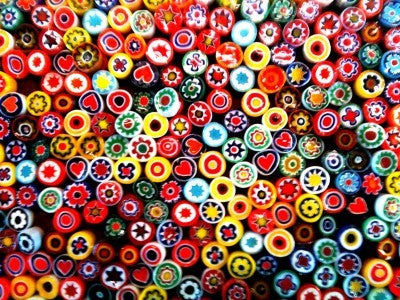Murrina (plural murrine) indicate coloured patterns or images made in a glass cane (long rods of glass) that are revealed when cut in cross-sections.
The term murrina, derives from Murrino, name given in 1878 by Vincenzo Zanetti, a Muranese priest and historian, who founded the Murano Glass Museum in 1861 with the intent to restore the lustre of Muranese glassmaking and relaunch the industry that was going through a deep crisis: he used this term to define vases and bowls created by the ancient Romans using a mosaic of glass tiles. These tiles were made with sections of the glass rods that features - inside them - abstract or even figurative designs such as faces, animals and flowers.
But let’s go back to the beginnings...
History of murrine art
In 61 b.C., Pompeo - a military commander and Roman politician, first ally and later opponent of Julius Caesar - brought to Rome some ‘murrna’ vases from Alexandria, made using glass canes with geometric or floral (called millefiori, ‘a thousand flowers’, in Murano) designs inside. The technique though, dates back to the Phoenicians.
These vases had a very peculiar feature: they had a pleasant scent due to the fact that they were used to contain and store perfumes. And that’s the origin of the name murrha: myrra in latin means myrrh, perfume. In the 1st Century b.C. the Romans begun a production of glass vases that reproduced those brought by Pompeo.
Unfortunately, the secret techniques used were lost during the Middle Ages. In the 16th Century the Muranese glass masters achieved a production of artworks that imitated the Roman murrine. The technique was then refined and brought back at the end of the 19th Century by Salviati Glassworks and Vincenzo Moretti. It reached its peak in the 20th Century, thanks to Artisti Barovier and Venini & C. glassworks.
Since then the term murrina is used to identify both the individual section of glass rods and the object obtained from their composition.
The murrine glass technique: how is it made?
Murrine can be found in items for Home Decor in Murano glass , such as vases, tableware, picture frames and more.
Murrine originate from a small amount of glass that is bonded to the metal rod of the master glassmaker. This glass is inserted in a star-shaped mould; after a brief immersion in water to cool it down, the glass is coated with a different color layer and equally cooled and inserted again into the mould. This process is repeated for several times until the desired design appears.
At this point the two ends of cylindrical mass (called Pastòn) are attached to two rods and pulled to several meters. The result is a long, thin rod which is cut into small sections. These sections are the murrine.
Murrine can now be heated and applied to the surface of a still hot glass artwork or arranged inside a die and fused together to form a single object (a trinket tray or picture frames in Murano glass , for example).







Dejar un comentario
Todos los comentarios se revisan antes de su publicación.
Este sitio está protegido por hCaptcha y se aplican la Política de privacidad de hCaptcha y los Términos del servicio.